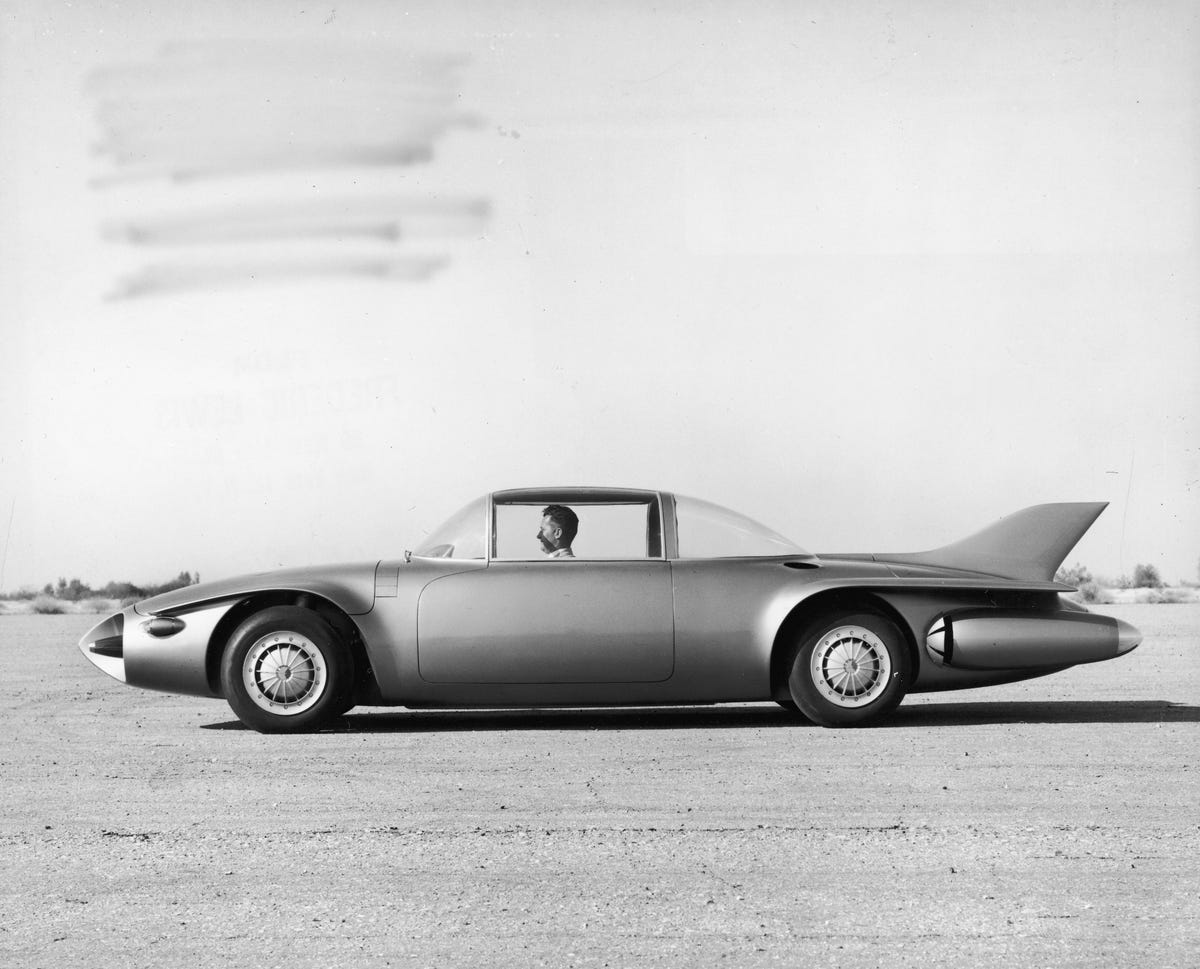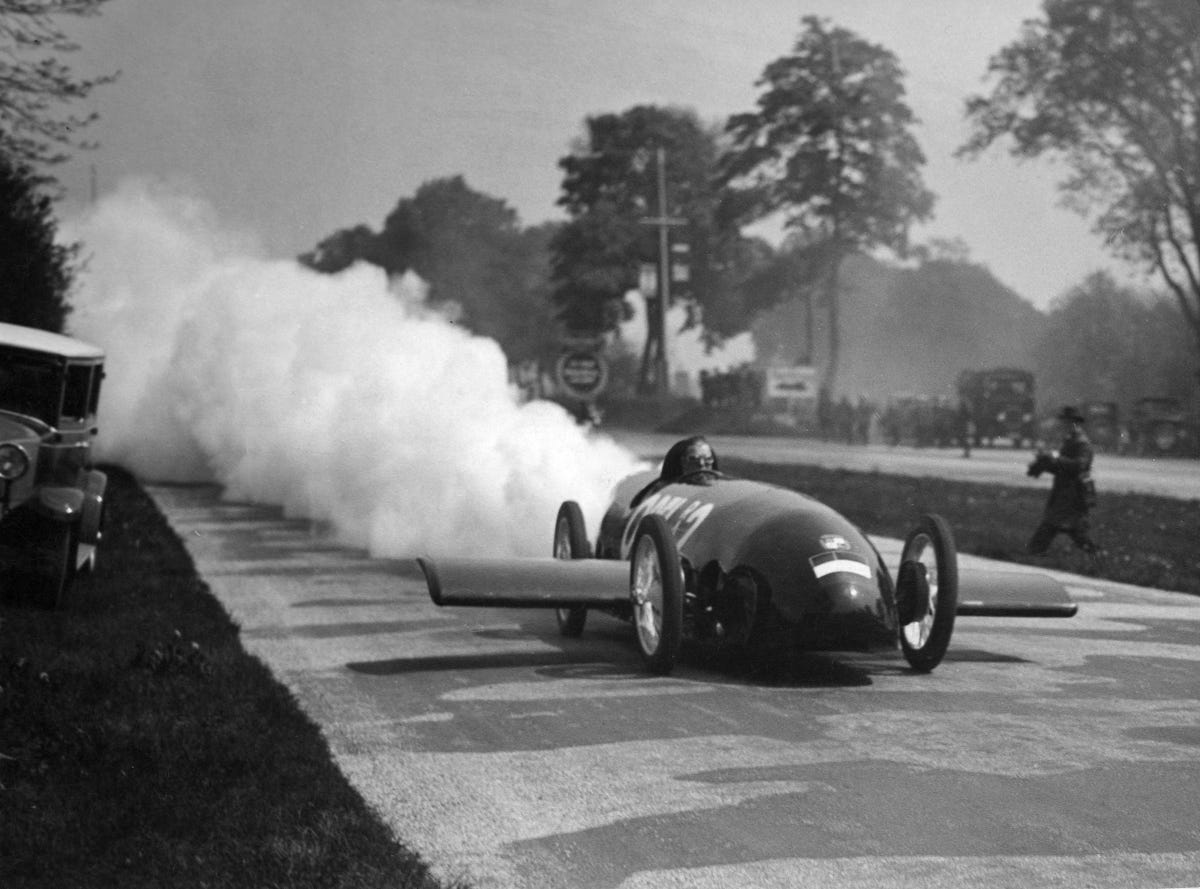
Dreaming of jet cars
Enter the jet age of the 1950s, when people began to regularly see jets screaming across the sky and could even fly across the country in the new jet airliners. Why not use this new motive technology to make really fast cars?
The idea wasn't entirely new, as wild-eyed inventors had been attaching rockets to cars since the late 1920s.
Although neither rocket nor jet ever found its way into our daily drivers, a few carmakers explored the technology's feasibility. Mostly, rockets and jets would be used over the following decades to conquer land speed records. The following examples highlight the history of rocket and jet propulsion in land-based wheeled vehicles.

Fritz von Opel's RAK 2
RAK 2 was Fritz von Opel's second attempt at creating a rocket-powered car. Its predecessor, RAK 1, showed disappointing performance.
RAK 2 used 24 solid-fuel rockets, and is also credited as the first car to use aerodynamic features, the wings on its sides, to achieve downforce. It reached a top speed of 143 mph on its test run in Berlin on May 23, 1928.
Fritz von Opel's RAK 2
RAK 2 builder and driver Fritz von Opel was the grandson of Adam von Opel, who founded the Opel car company. The Opel brand lives on in Europe as a subsidiary of GM.
Fritz also tested rocket-powered planes, a train and a motorcycle in the late 1920s.
Volkhart R1
Kurt Volkhart, who had driven Opel's RAK 1, tried to beat the RAK 2's speed record of 143 mph with his Volkhart R1. However, the Volkhart R1 could only make it up to 97 mph on its test run on March 9, 1929.
Volkhart R1
The Volkhart R1 has a tandem passenger seat, behind the driver, which could be covered with a body shell.
Volkhart R1
Kurt Volkhart would go on to test a rocket-powered motorcycle. Previously, he had raced a conventional 500-cc motorcycle in the ADAC Eifelrennen race of 1928, on the Nurburgring.
Valier-Heylandt RAK 7
Max Valier, who had worked with Fritz von Opel on his rocket car, went on to work with Paul Heylandt, a German rocket scientist. They built and tested the RAK 7, shown here.
The RAK 7 managed 90 mph when it was tested at Berlin's Tempelhof airport on April 19, 1930. Rather than trying to set a speed record, Valier and Heylandt used the car as a test platform for their rocket technology, with the assumption that rockets would only be practical for air and space travel.
Valier-Heylandt RAK 7
The big advance with Valier and Heylandt's research came in the use of liquid fuel for their rockets, as opposed to the solid fuel used in Fritz von Opel's rocket car. The tanks shown under the hood of the RAK 7 hold liquid oxygen and benzene, which are mixed and ignited to give the car thrust.
Sadly, Valier was killed when a rocket motor he was testing in the lab blew up on May 17, 1930.
Paul Heylandt Comet Car
Undeterred by Valier's death, Paul Heylandt went on to further develop liquid-fueled rocket technology. He tested the Comet Car at Tempelhof airport on May 2, 1931. It reached 90 mph and could have gone faster, but according to a report published in The American Interplanetary Society's Bulletin at the time, the driver had to hold down the speed because "of the lack of banked curves on the airport field."
Paul Heylandt Comet Car
An article in the New York Times reported that Heylandt's car maintained speed of over 80 mph for 14 minutes, and that it "weighs two tons but steers easily." Heylandt said of this test that the car was too fast and the flame coming out the back too dangerous for use in production, emphasizing the use of rockets for flight.
Paul Heylandt Comet Car
Heylandt's company produced liquid oxygen, when was used in the Comet Car's motor. During World War II, Heylandt supplied liquid oxygen to power Germany's V2 rockets.
GM XP-21 Firebird 1
As jet engines were developed for aircraft during and after World War II, GM seriously looked at developing the propulsion technology for cars. It showed off the XP-21 concept car in 1953, liberally borrowing styling cues from jet planes.
GM XP-21 Firebird 1
The XP-21 did not, however, use its gasoline-turbine engine for direct thrust, instead capturing that power to turn the rear wheels. In testing, the XP-21 drove up to 100 mph before the engine's torque caused the tires to disintegrate.
Spirit of America
The turbojet-powered Spirit of America marked the start of a new era of jet-propelled cars trying to set land speed records. Racecar driver Craig Breedlove piloted the Spirit of America to over 400 mph on September 5, 1963, at the Bonneville Salt Flats in Utah, setting a speed record for a wheeled vehicle.
Spirit of America
The Spirit of America used the engine from an Air Force F-86 Sabrejet, which produced 5,670 pounds of thrust. On October 14, 1964, Breedlove made another run with the Spirit of America, this time setting a land speed record of 526 mph.
Green Monster
Drag racer Art Arfons entered the land speed record fray with Green Monster, his jet-powered car, claiming the title on October 5, 1964 with a speed of 434 mph. The Green Monster used the engine from an Air Force F-104 Starfighter, producing 11,905 pounds of thrust.
Green Monster
Arfons, who served with the Navy in World War II, developed a number of combustion engine dragsters before building the land-speed-record-breaking Green Monster. Acknowledging that jet-powered cars weren't really automobiles, he described them as "giant blowtorches" in a Popular Science article at the time.
Green Monster
Arfons made more land speed attempts with Green Monster, hitting 537 mph on October 27, 1964, and reachng his maximum recorded speed of 577 mph on November 7, 1965. He ultimately lost the title during this period to Craig Breedlove's second Spirit of America jet car, which recorded 594 mph on November 15, 1965.
Wingfoot Express 2
Tom Green and Walt Arfons, half-brother of Art Alfons, set a land speed record of 413 mph with their original Wingfoot Express car on October 2, 1964, and attempted to regain their title Wingfoot Express 2. Rather than the turbo-jet engines used by their first car and competitors of the time, they fitted Wingfoot Express 2 with 24 jet-assisted take-off bottles (JATO), actually solid-fueled rockets.
Wingfoot Express 2
Boasting almost 50,000 horsepower, Wingfoot Express 2 only hit 476 mph during its record attempt in 1965, falling short of brother Art's earlier speed of 536 mph. Green and Arfons claimed a speed of 605 mph during testing, although that was never achieved on an officially timed run.
Thrust SSC
While a few more land speed records were set after the intense battles of the mid-1960s, it wasn't until October 15, 1997 that a car went faster than the speed of sound. Thrust SSC achieved a speed of 763 mph on Nevada's Black Rock Desert.
Thrust SSC
British Royal Air Force pilot Andy Green drove Thrust SSC in its record-breaking run. The car, with jet engines producing over 50,000 pounds of thrust, weighed 21,200 pounds and was 54 feet long.
Bloodhound SSC
Green's supersonic land speed record still stands, but UK-based Bloodhound Company is looking to upset it with the Bloodhound SSC. Beyond merely setting a new land speed record, Bloodhound SSC is designed to go over 1,000 mph.
Bloodhound SSC
According to Bloodhound SSC's design, this Rolls-Royce jet engine will bring it up to 600 mph, at which point a cluster of rockets will fire, pushing it over 1,000 mph. This combination makes Bloodhound SSC a sort of rocket-jet car, combining the best of both worlds.
Bloodhound SSC
Bloodhound plans to test the car in South Africa this year, followed by a record run in 2017.
FireForce 3
Beyond the big land-speed-record setters, less prominent cars show off direct thrust power. The above is FireForce 3, based in the UK, which holds its own record as the fastest jet funny car, having hit 336 mph in 2005.
FireForce 3
FireForce 3 uses a Pratt & Whitney turbojet engine taken from a Sikorsky Skycrane helicopter, which makes 5,50o pounds of thrust.
'Buckaroo Banzai' jet car
We couldn't leave out the jet car from the 1984 movie "The Adventures of Buckaroo Banzai Across the 8th Dimension." Really just a modified Ford F-350 pick-up truck, the movie depicts a desert speed run culminating with the truck disappearing into a mountain.

